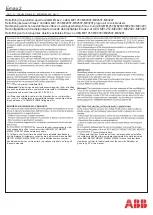
91
4
Environment and usage precautions
4-2 Application to special environments
4-2 Application to special environments
4-2-1
High-temperature, high-humidity
applications
(1) High temperature condition
The temperature of each component of an MCCB is the
sum of the ambient temperature and the temperature rise in
the component due to current flow in the MCCB. When the
ambient temperature is higher than 40°C, the continuous
carrying current should be derated to keep the temperature of
MCCB internal insulators and other materials within standard.
Thermal-magnetic type circuit breakers without a temperature
compensation device tend to trip with currents below their
rated current. It is recommended that the continuous carrying
current be reduced to the current shown in Table 4-2.
Table 4-2 Current decrease due to ambient temperature
Ambient temperature (°C)
Decrease
50
90% max.
60
80% max.
(2) High humidity condition
MCCBs to be used in excessively humid locations should be
housed in a moisture-proof cabinet, or thorough maintenance
and inspection should be conducted to prevent loss of
insulation properties or rusting of metallic mechanical parts.
When an MCCB is housed in a moisture-proof enclosure, the
temperature inside the enclosure is liable to change suddenly
when the related equipment is powered up or shut down,
and condensation may form. This problem can be averted by
installing a heater inside the enclosure.
4-2-2 Cold climate applications
At –5°C or lower temperatures, MCCB metallic parts and
insulators may become brittle and the viscosity of the lubricant
used in its mechanical parts changes; therefore, provisions
should be made to avoid low ambient temperatures, such as
installing near a heater. Since the operating characteristics of
a thermal-magnetic type MCCB are temperature dependent,
the MCCB’s relationship to the equipment it is to protect must
be considered when choosing the appropriate current rating.
Although the switching, trip, and short-circuit interruption
characteristics are not adversely affected at –20°C, installation
of a heater nearby is recommended to reduce adverse effects
of low temperatures. When shipped, temperatures as low
as –40°C present no problem, but the breakers should be
shipped in the off or tripped state to minimize brittleness.
4-2-3 High altitude applications
Special care must be taken when using MCCBs at altitudes
higher than 2000m because the lower air pressure (about
0.8atm at 2000m and about 0.5atm at 5500m) at higher
altitudes reduces the cooling effect and dielectric strength of
the air. When using MCCBs under these conditions, multiply
the rated voltage and rated current by a correction factor from
Table 4-3 as recommended by ANSI C37.13-1981. Observe
the preceding precautions for cold climate applications as well
because temperatures generally drop at higher altitudes.
Table 4-3 Rated voltage and rated current correction factors for
high altitude
Altitude (m)
Rated voltage
Rated current
2000m max.
1.00
1.00
2600m max.
0.95
0.99
3900m max.
0.80
0.96















































